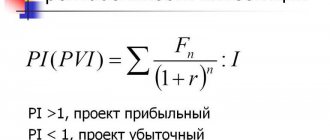NPV is the total value of cash flows at a certain point in time in the life cycle of a project. In other words, this is a future financial result equivalent to the current amount. The abbreviation stands for Net Present Value.
To calculate NPV, discounted cash flows that are already familiar to us are used, which determine the return on investment at any point in time. By performing a preliminary calculation of the NPV of an investment project, we will get an approximate idea of how much money will be needed at the initial stage and whether it is worth investing in this project at all.
Today we will calculate NPV using the formula and learn how the net present value method is used to calculate the amount of initial investment and the payback period of a project.
What is NPV and why is this indicator needed?
To put it simply and clearly, this is an indicator of how much profit the investor will receive from the project. It is noteworthy that NPV shows the financial result in the equivalent of today's amount. This is especially important because $1,000 today will not be worth $1,000 in 5 or 10 years.
Thanks to this indicator, you can compare the expected results of different investments and choose the most attractive option.
Pros and cons of the counting system
Of course, for the most part this calculation is useful. However, if you look carefully, then NPV-type calculations also have their drawbacks.
Positive sides
- Gives directions.
- Helps to weigh all risks and determine approximate benefits.
Negative
The point is that the economy is constantly moving. Because of this:
- It is impossible to calculate all the risks and be one hundred percent sure that you will not burn out. After all, the formula uses fixed numbers, but in reality they are constantly changing.
- To minimize risks in calculations, a minimalist policy is used. That is, all profits are considered at a minimum. This may result in the investor rejecting a successful and profitable project.
Thus, NPV is a very useful economic tool. However, it is worth remembering that it is created as an approximate calculation, and relying entirely on its results is risky.
Possible difficulties in calculation
When calculating, they rely on several estimates and assumptions, since the indicator may contain errors. After the first analysis, a repeat analysis is necessary to double-check the estimates.
The calculation results may become erroneous if the following factors are not taken into account:
- Discount rate. Today, you use point-in-time percentage to calculate earnings. However, after a few years, the interest rate will rise significantly and the value of the funds invested in the project will increase. In other words, the income you planned for a given year will be less valuable.
- Initial investment. If you purchase equipment at a fixed price, there will be no problems. If you constantly need to update equipment during the production process, the calculated amount will become very arbitrary.
How to calculate the NPV of an investment project - a guide
Step-by-step algorithm for calculating the NPV of an investment project:
- We determine how much money we are willing to invest at the initial stage.
- We roughly calculate the amount of revenue for each year of the project.
- We calculate the associated costs.
- We determine the discount rate, or the cost of capital.
- We calculate discounted cash flows at this rate.
- We sum up the obtained values for all years.
- Let's analyze the result: if NPV = 0, this means that the invested funds, taking into account the expected income, will be sufficient. If the value is positive, it means the project will be profitable, and the higher the NPV, the better. A negative NPV value indicates that the project is unprofitable.
Discount rates
The discount rate is an interest rate. It is used to reestimate the current value of future capital. In other words, any amount you have in your hands now is worth more than it will be in the future. 10,000 rubles today is more valuable than 10,000 rubles in 5 years.
Having invested 10,000 rubles now, no matter in a bank or in a project, in the future you will receive, say, 15,000 rubles. The difference between these two forces, expressed as a percentage, is the interest rate.
Advantages and disadvantages
The advantages of the method are as follows:
- NPV takes into account the time factor - changes in the value of money and the duration of the life cycle of the investment project.
- To a large extent, it reflects the main criteria for the effectiveness of investments: risk assessment, calculation of the payback period and the difference between income and expenses, taking into account inflation.
Flaws:
- Predicting cash flows is not easy - there will always be factors that cannot be taken into account in advance.
- Complex mechanism for calculating the discount rate. More precisely, the difficulty is not in the formula for calculating it, but in choosing the right method. By choosing the wrong method, you can get an NPV value that is far from the truth.
Calculation example
For an example of calculation, I will take two companies - A and B.
| Firms | A | B |
| Attachments | — 1 000 000 | — 500 000 |
| Receipt of money in the first year (F1) | 800 000 | 200 000 |
| Receipt of money in the second year (F2) | 500 000 | 510 000 |
| Present value of F1 and F2 at a discount rate of 10%. Shows how much you must invest today to get the value of F1 and F2. Р=Fn/(1+r)^n, where Fn is the future value, r is the average discount rate, n is the time period | 1 140 496 | 603 306 |
| NPV (present value - investment) | 140 496 | 103 306 |
Firm A's NPV is higher. In both cases, the indicator is positive, which means the project is accepted.
IFRS, Dipifr
Investing means investing free financial resources today in order to obtain stable cash flows in the future. You can invest in financial instruments, or in a new business, or in expanding an existing business. In any case, investing is investing money in some assets for the long term.
How not to make a mistake and not only return the invested funds, but also get a profit from the investment?
To do this, you can use one of the methods for assessing the effectiveness of investment projects. NPV is one such method. Finding the NPV of an investment project means finding the net present value of all the cash flows associated with that project.
How to do this using the formula for calculating NPV, and whether it is so difficult, read below.
What can you do with money?
If you have a certain amount of money, then there are three ways to dispose of it:
- a) spend
- buy a large apartment and live in it, buy a car and drive it to work, go on vacation to Hawaii. Everyone has their own options, because you don’t need advisors to spend money. - b) hide it
in a safe for a rainy day. And always worry that they will be stolen. And sadly watch how they depreciate as a result of inflation - c) “invest” (invest)
somewhere with the aim of generating income in the future. Will this be beneficial?
This article is for those who choose the third item from this list. And it doesn’t matter whether you are going to invest your own money or the money of the company in which you will work as a financial specialist.
You can invest in a bank by putting money on deposit, or you can buy debt obligations or shares of banks or companies that are freely traded on the financial market. This is the easiest way, but not the most profitable. For individuals, that is, you and me, most often this is the only way to invest savings.
Or you can invest in a business, which means buying long-term assets (fixed assets), using which in the process of production, trade or provision of services, you will receive cash inflows in the future. For legal entities (companies), this, in fact, is the purpose of their existence - to make money (profit) from investments.
To determine whether a particular investment project will be successful, financial specialists use certain methods for evaluating projects. The two main methods are NPV and IRR .
NPV - what is it? What is the logic in this indicator?
NPV is an abbreviation for the first letters of the phrase " N"
et
P
resent
V
alue” and this stands for net present value (as of today). This is a method of evaluating investment projects based on the discounted cash flow methodology.
If you know a promising business project and want to invest money in it, then it would be a good idea to first calculate the NPV (=net present value) of this business project. The calculation algorithm is as follows:
- 1) you need to estimate the cash flows from the project - the initial investment (outflow) of funds and the expected receipts (inflows) of funds in the future
- 2) determine the cost of capital for you - this will be the discount rate
- 3) discount all cash flows (inflows and outflows) from the project at the rate that you estimated in step 2)
- 4) Fold. The sum of all discounted flows will be equal to the NPV of the project
Rule: if NPV is greater than zero, then the project can be accepted; if NPV is less than zero, then the project should be rejected.
Rationale for the NPV Method
very simple. If the NPV is zero, this means that the cash flows from the project are sufficient to
- a) recoup the invested capital and
- b) provide the necessary income on this capital.
If the NPV is positive, it means that the project will bring profit, and the higher the NPV value, the more profitable/profitable the project is. Since the income of the creditors (who you borrowed money from) is fixed, all income above this level belongs to the shareholders. If the company approves a project with zero NPV, the shareholders' position will remain unchanged - the company will become larger, but the share price will not increase. However, if the project has a positive NPV, the shareholders will become richer.
NPV formula - calculation example
The formula for calculating NPV looks complicated to a person who does not consider himself a mathematician:
Where:
- n, t — number of time periods,
- CF — cash flow (Cash Flow),
- R — cost of capital (discount rate, Rate)
In fact, this formula is just a correct mathematical representation of the summation of several quantities. To calculate NPV, let’s take as an example two projects A and B, which have the following structure of cash flows in the next 4 years:
Both projects A and B have the same initial investment of 10,000, but the cash flows in subsequent years are very different. Project A has a faster return on investment, but by the fourth year the cash flow from the project will drop significantly. Project B, on the other hand, has lower cash inflows than Project A in the first two years, but Project B will generate more cash than Project A in the next two years.
Let's calculate the NPV of the investment project as follows:
Assumptions to simplify the calculation:
- a) all cash flows occur at the end of each year,
- b) the initial cash outflow (investment of money) occurred at time “zero”, i.e. Now
- b) the cost of capital (discount rate) is 10%
There is a separate article on discounting cash flows on this site. If the calculation below seems completely incomprehensible to you, then it would be better to first remember the basics of discounting by returning to this article. Let me briefly remind you: to bring the cash flow to today, you need to multiply the amount of money by the coefficient 1/(1+R), while (1+R) must be raised to a power equal to the number of years. The value of this fraction is called the factor or discount factor. In order not to calculate this factor every time, you can look it up in a special table called the “discount factor table.”
Let's apply the NPV formula for Project A. We have four annual periods and five cash flows. The first flow (10,000) is our investment at time zero, that is, today. If we expand the NPV formula given just above, we get a sum of five terms:
If we substitute into this amount the data from the table for Project A instead of CF and the rate of 10% instead of R, we obtain the following expression:
What is in the divisor can be calculated, but it is easier to take the ready-made value from the table of discount factors and multiply these factors by the amount of cash flow.
As a result, the present value of cash flows (NPV) for project A is 788,2
dollar. The NPV calculation for project A can also be presented in the form of a table and in the form of a time scale:
The NPV for project B is calculated in exactly the same way.
Since discount factors decrease over time, the contribution to the present value of the project from large (4,000 and 6,000) but distant (third and fourth years) cash flows will be less than the contribution from cash receipts in the first years of the project. Therefore, it is expected that for Project B the net present value of cash flows will be less than for Project A.
I found that the NPV of Project B is $491.5.
The NPV calculation for project B can be seen in the table and in the figure with a time scale.
Conclusion:
both projects can be accepted, since the NPV of both projects is greater than zero, which means that the implementation of these projects will lead to an increase in the value of the investor company.
If these projects are mutually exclusive, that is, it is necessary to choose one of them, then Project A looks preferable, since its NPV is noticeably higher, 788.2, than the NPV of Project B, 491.5.
Numbers for calculating the NPV of an investment project - what is the difficulty?
Applying a mathematical formula is not difficult if all the variables are known. Once you have all the numbers - cash flows and cost of capital - you can easily plug them into the formula and calculate NPV. But it's not that simple. Real life differs from pure mathematics in that it is impossible to accurately determine the magnitude of the variables that enter into this formula. As a matter of fact, this is why in practice there are many more examples of unsuccessful investment decisions than successful ones.
a) Cash flows
The most important and most difficult step in analyzing investment projects is assessing all the cash flows associated with the project. Firstly, this is the amount of the initial investment (outflow of funds) today. Secondly, these are the amounts of annual cash inflows and outflows that are expected in subsequent periods.
Making an accurate forecast of all the costs and revenues associated with a large, complex project is incredibly difficult. For example, if an investment project is associated with the launch of a new product on the market, then to calculate NPV it will be necessary to make a forecast of future sales of the product in units and estimate the sales price per unit of product. These forecasts are based on an assessment of the general state of the economy, the elasticity of demand (the dependence of the level of demand on the price of a product), the potential effect of advertising, consumer preferences, and the reaction of competitors to the launch of a new product.
In addition, it will be necessary to make a forecast of operating expenses (payments), and for this to evaluate future prices for raw materials, employee salaries, utilities, changes in rental rates, trends in changes in exchange rates, if some raw materials can only be purchased abroad, etc. Further. And all these assessments need to be made several years in advance.
b) Discount rate
The discount rate in the NPV calculation formula is capital for the investor. In other words, this is the interest rate at which the investing company can attract financial resources.
In general, a company can obtain financing from three sources:
- borrow (usually from a bank)
- sell your shares
- use internal resources (retained earnings)
Examples of calculations in business plans
I will give the following data: initial investments - 150 million rubles, receipts in the first year - 30 million rubles, in the second and third - 70 million rubles, in the fourth - 45 million rubles. Next, I will consider two cases - the cost of capital is constant at 12%, and it will change over the years - 12, 13, 14, 14%.
First case: according to the formula
we find that NPV = 11.0 million rubles, which means the project is accepted.
In the second case I get the following result:
This indicates that the project is unacceptable.
How to calculate NPV in Excel
Here is an example of calculating the net present value indicator NPV in Excel using the following input data:
- project cost – 3,750,000 rubles. ($50,000 or 1,450,000 UAH);
- projected cash receipts: for the first year - 375,000 rubles. ($5,000 or 145,000 UAH), then an increase of 30% is planned;
- expenses – 41,250 rub. ($550 or 15,950 UAH) in the first year, then we increase them by 5% annually.
First we will calculate the discount rate using Fisher's formula. As a nominal rate, we will take the key rate of the Central Bank equal to 4.25%. Inflation is 4%.
\( (1+r)=(1+4.25)+(1+4); \)
\( r=9.25 \%. \)
We used the NPV function built into Excel. If you change the value of r, you can determine that as the discount rate increases, the NPV of the project decreases. Thus, a lot depends on the correct calculation of this indicator.
As you can see, in the sixth year, with a positive NPV value, the project begins to make a profit. The amount of negative cash flows shows the amount of loss for the current year.
conclusions
Thus, it is clear that the calculation of net present value is crucial when conducting an investment analysis of any project. Bringing the cost of the project to the current moment and comparing it with alternative investment methods allows you to understand the feasibility of investing in the project.
NPV indicator and other investment parameters are the most important part of business planning. In order to draw up a reliable business plan, we recommend a ready-made business plan with a financial model that allows you to calculate the above indicators automatically. You can also contact professionals in the field of investment analysis to develop such a document, who will be able to develop a turnkey business plan taking into account the characteristics of your business.
Basic rule of investing
The main purpose of determining net present value ( NPV ) is to compare the results of investing in a project with the profitability of using financial resources in an alternative way.
The main rule can be formulated as follows:
NPV > 0 - investments in the project will be profitable, the project is profitable;
NPV = 0 - investments in the project will bring neither profit nor loss, the project is break-even;
NPV < 0 - investments in the project will be accompanied by losses, the project is unprofitable.
The feasibility of investing in a project is confirmed if the NPV is positive (greater than zero). Otherwise ( NPV is less than zero), the project should be rejected.
If the net present value as a result of calculations turns out to be zero, we can assume that the planned cash flows will be able to compensate for the volume of investments - that is, we will reach the break-even level.
The greater the NPV value, the greater the profit from implementing the business idea in the future.
***
In conclusion, it should be noted that when making an investment decision, you should definitely evaluate the profitability of the project. This is done using the NPV given in our article.
Similar articles
- Rules for calculating the minimum tax under the simplified tax system
- Formula for calculating the net profit rate
- Test yourself - personal income tax problems with solutions
- How to calculate income tax on an accrual basis?
- Net working capital
Investment options
There are three ways to manage project funds: spending, saving, investment. The simplest, but not the most profitable option is to invest in a bank, purchase debt obligations or bank shares that are freely traded on a financial exchange.
However, the best investment step would be to invest in expanding your own business. This implies the purchase of long-term financial assets (fixed assets or fixed assets), the use of which in trade or production processes will generate stable financial income.
To determine the success of a particular investment project, business experts use specific techniques for analyzing business plans. The assessment uses two key mechanisms:
- IRR, otherwise InternalRate of Return translated from English - internal rate of return;
- NPV or Net Present Value - net present value.
The NPV of a project represents the coefficient of profit received by participants in investment business projects. From the point of view of NPV mathematics, this parameter is calculated through discounted indicators of net financial flows, despite the values of both “+” and “-”. NPV can be determined for any time period, counting from the moment the project is opened.
Brief description of present value
When a person invests his money in the cost of a business project, he must study the feasibility of these manipulations from an economic point of view. After all, the user is interested not only in fully recouping all the funds spent, but also in receiving additional cash in addition to the initial contributions. In addition, the specialist must find alternative investment methods that, with the same risk, bring a better level of income. In order not to lose your capital, you need to determine in advance the net value of the idea (reduced NPV). This approach has many advantages.
Net present value represents a universal indicator of efficiency for a project. All calculations are carried out by discounting estimated financial flows (expenses and income). Profit is indicated by the net cost estimate of the project plan. When financial flows fully cover all initial investment costs and periodic financial outflows, it will be possible to add accurate data.
https://youtube.com/watch?v=bsnE3jk6IDE
The calculation of the present value indicator itself should be carried out in stages:
- The expert must find the differences between the projected profit and investment costs for each time period (most often a year).
- The discount rate is determined. In order not to make mistakes in the calculations, you need to realistically assess the cost of the available capital.
- All obtained results must be brought up to the moment of today (the expert must calculate the discount for each financial flow separately for each time period).
- At the final stage, you need to add together all incoming and outgoing funds. The final value will express the present value, reflecting the total profit for the investor.
Problem of finding NPV
Example . The initial investment in project A is 10,000 rubles. The annual interest rate is 10%. The dynamics of revenues from years 1 to 10 are presented in the table below:
| Period | Tributaries | Outflows |
| 0 | 10000 | |
| 1 | 1100 | |
| 2 | 1200 | |
| 3 | 1300 | |
| 4 | 1450 | |
| 5 | 1600 | |
| 6 | 1720 | |
| 7 | 1860 | |
| 8 | 2200 | |
| 9 | 2500 | |
| 10 | 3600 |
For clarity, the corresponding data can be presented graphically:
Figure 1. Graphical representation of the initial data for calculating NPV
It is necessary to calculate the NPV indicator.
Standard solution. To solve the problem, we will use the NPV formula we already know:
We simply substitute known values into it, which we then sum. For these calculations we will need a calculator:
NPV = -10000/1.10 + 1100/1.11 + 1200/1.12 + 1300/1.13 + 1450/1.14 + 1600/1.15 + 1720/1.16 + 1860/1.17 + 2200/1.18 + 2500/1.19 + 3600/1.110 = 352.1738 rubles .











